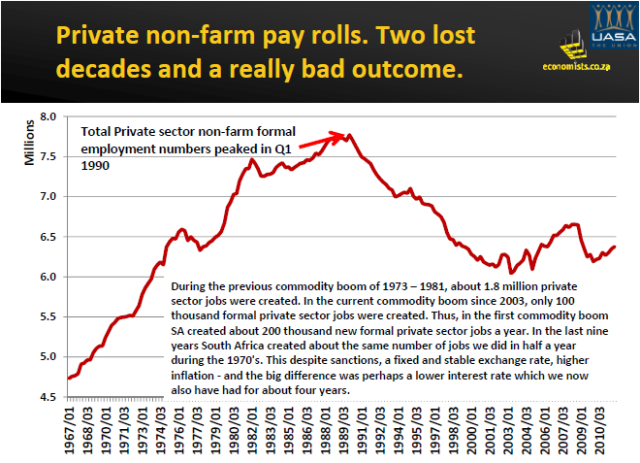2012 UASA South African Employment Report Can South Africa afford itself?
South Africa's lack of employment has now become a crisis that is over two decades old and we have yet to get beyond the slogans.
In its 2012 South African Employment Report (SAER), which was presented by economist Mike Schussler in Johannesburg today, the trade union UASA suggests that South Africa should employ people in "training" jobs at lower salaries for a period of time to enable them to gear up their employability. UASA also believes that a starting wage subsidy may help lower the effective salaries of unskilled and semi-skilled people and could make a difference in the rate of unemployment.
The problem seems to be that the cost of producing goods and services in South Africa has risen too quickly. Unskilled wage rates have rocketed about twice as quickly as in the rich world, after inflation, while management and specialised skills are often underpaid.
These factors, more than anything else, explain why people cannot find work as the price of certain labour has become unaffordable. South Africa's unskilled earn too much in both relative and in absolute terms.
Not many of us know that in the 2nd quarter of 2011, less people were employed in manufacturing in South Africa than any time since 1972, said Schussler.
"This is not the kind of detail that we want to see splashed across headlines, but the fact is that the productive sectors in South Africa have now struggled for decades to create employment."
"The overall non-agriculture private formal sector employment, while higher than a year ago, is still over 1,4 million employees fewer than in 1980, or about 30 years ago.
"Furthermore South Africans are twice as likely to be employed in the public sector today than 40 years ago. The public sector has grown from 11% of total formal employment in 1970 to over 22,8% today. This means that South Africa has more civil servants than the total number of people employed in mining and manufacturing combined. This is apart from the fact that more people get an income from welfare than from employment," said Schussler.
"This is an unsustainable situation as we need the productive (income generating and exportable) part of the economy to function and produce products at a lower cost. It is difficult to compete with other countries or even to create enough profits to encourage further employment if government employment is at such high levels," he said.
Apart from the fact that government employs over 22,8% of the formal sector workers, it also pays higher wages than the private sector. In 2011 the average government salary was 34% higher than the private sector. Government salaries account for more than 12,8% of GDP and together with the salaries paid by state owned enterprises, they add up to over 14,3% of GDP, one of the highest numbers in the world today. Some countries with similar figures, e.g. Portugal, Greece and France, are facing debt payment crises today, said Schussler.
The 2012 UASA SAER also looks at the wage gap. It finds that the often quoted "poor working class" rhetoric is just that, said Schussler, a slogan with far less truth today than thirty years ago.
"If it were true then unions would have been a dismal failure over the last two decades. The old ‘work poor' have become the reasonably comfortable class of today.
"However, the salaries of senior employees and managers in South Africa, either in government or the private sector, are also lower than one would think. Using both the Patterson and Hay grading systems, research shows that wages in the unskilled and semi-skilled part of the labour force are too high while at the same time, evidence shows it is exactly these citizens that are struggling to get work," added Schussler.
"While previous UASA employment reports pointed at both the lack and the low quality of skills in South Africa, the country cannot afford to overpay the unskilled and semi-skilled employees. This is probably the leading result of unemployment in the economy. A commercial look at South African employment in both relative and absolute terms is that unskilled employees are indeed overpaid. A commercial venture needs to produce goods at a profit in order to survive and have probably, in most cases, now mechanised as much as they can, the latter helped along by lower interest rates."
The UASA research also shows that the biggest wage gap or difference in the South African economy is not between those employed, even if one looks at labourers and managers, but between the low paid labourers and those on welfare. While the 90thpercentile and the 10th percentile has a difference of about 5,7 times, the difference between someone with a child grant and the 10th percentile is about 19 times. Furthermore, the employed make up only 4 out of every 10 adults and so are in a relative sense the rich in South Africa. The state employs nearly 8% of all adults and this 8% walks away with 14,3% of our county's wealth.
"Compared to other countries, those with skills in the SA formal sector are often underpaid in relative terms, while those with relatively few skills are overpaid. It is not conducive for development or further employment creation if nearly 60% of the unemployed are unskilled.
"This, more than anything else, helps to explain South Africa's lack of job creation over the last two or three decades. The biggest factor seems to be the fact that the unskilled earn too much in both relative and in absolute terms. South African salaries seem to be on par with rich countries rather than with developing countries. Our starting salaries in many categories are very good in both relative and absolute terms but salaries in many management and skilled categories are on par or too low while our productivity is closer to developing countries," said Schussler.
As an example, the 2012 UASA SAER shows that starting salaries for teachers in SA are relatively good and just 4% below the rich world average and higher than a simple multi country average by about 16%. Maximum salaries, however, fall to 73% of rich world average while they are also below the multi country average.
The report shows that South African medium and higher salaries are not excessive and are mostly on par with what they should be despite the skills shortage in the country.
The UASA SAER also points out that both the state and state owned enterprises employ very few unskilled people although most of the unemployed in South Africa are unskilled. This shows that even if the state did employ more people they would not fundamentally address the unemployment problem. While the salary bill of both the state and public enterprises are rather high, the fact is that management and specialised skills are often underpaid which makes real service delivery difficult.
The difference between the 10th percentile and the 90th percentile in about 4 times in salary, which is close to very equal societies such as Norway. However, with the SA skills shortage one would expect that the difference should be closer to Singapore where the difference is closer to 10 times.
South Africa is the only country in the world which has had an unemployment rate over 20% for 15 years, remarked Schussler. The UASA SAER shows us why this is and is very honest in its assessment.
The problem is that the cost of producing goods and services in South Africa has risen too quickly. Unskilled wage rates have rocketed about twice as quickly as in the rich world (after inflation). This, more than anything else, explains why people cannot find work as the price of certain labour has become unaffordable. As was pointed out in the 10th UASA SAER, fewer adults are employed as a percentage of the population than in 1990. The growing numbers of the unemployed, or simply adults not in work, is an increasing political risk factor for South Africa.
UASA suggest that South Africa should employ people in "training" jobs at lower salaries for a period of time to enable them to gear up their employability. UASA also believes that a starting wage subsidy may help lower the effective salaries of unskilled and semi-skilled people and could make a difference in the rate of unemployment.
The lack of employment has now become a crisis that is over two decades old and yet we have to get to beyond the slogans. UASA wishes to engage in real debate with real solutions and not just slogans. South Africa cannot afford too high wages in certain categories and industries as it brings low employment and a lack of dignity.
This is the 11th consecutive year the UASA SAER has been researched and presented.
To download full Employment Report, click here: http://www.uasa.org.za/images/pdf/report11.pdf
Statement issued by UASA, May 4 2012
Click here to sign up to receive our free daily headline email newsletter


